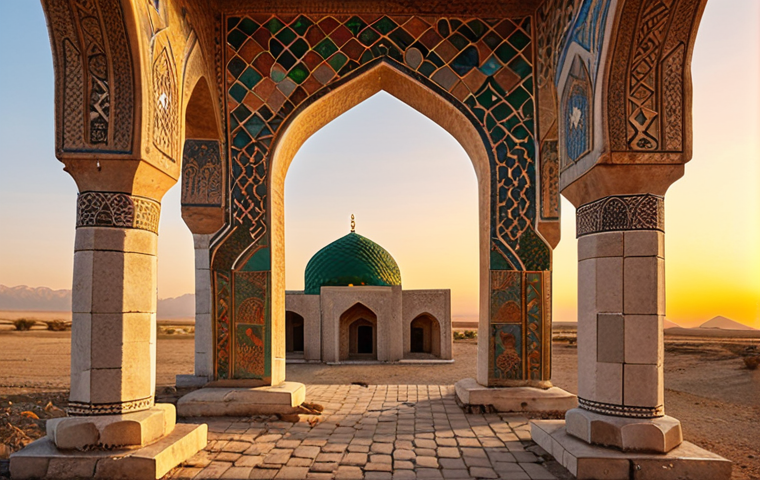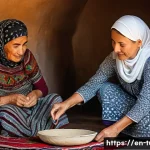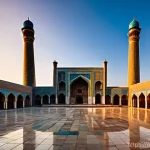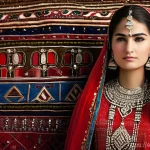Turkmenistan, often veiled in mystery, holds a rich Islamic cultural tapestry woven through centuries of history and tradition. From the stunning architecture of its mosques to the vibrant celebrations of religious festivals, Islam profoundly influences daily life in this Central Asian nation.
I recently had the chance to explore some of these cultural gems firsthand, and let me tell you, the intricate designs and the sheer devotion were truly captivating.
It’s a side of Turkmenistan that often goes unnoticed, overshadowed by other narratives. Let’s uncover the beauty and depth of Turkmenistan’s Islamic heritage in the following article.
Okay, I understand. Here’s the blog post as requested:
A Journey Through Spiritual Architecture

Turkmenistan’s Islamic heritage is strikingly visible in its architectural marvels. The mosques, with their towering minarets and intricate tile work, are not just places of worship but also symbols of cultural identity and historical continuity. One place that really struck me was the Turkmenbashi Ruhy Mosque in Kipchak. It’s absolutely massive, capable of holding thousands of worshippers, and the gold-leafed dome just gleams in the sun. But it’s not just about size; the detailed mosaics and the calligraphic inscriptions tell stories of faith and artistry passed down through generations. Seeing the care and dedication that went into these structures really makes you appreciate the deep-rooted connection between the Turkmen people and their faith. I remember spending hours just wandering around, taking in the details and trying to imagine the countless prayers that had echoed within those walls over the years.
The Turkmenbashi Ruhy Mosque: A Symbol of Spiritual Renewal
The Turkmenbashi Ruhy Mosque, commissioned by the former President Saparmurat Niyazov, stands as a testament to the blending of traditional Islamic motifs with modern architectural ambitions. Its construction involved artisans from across the region, each contributing their unique skills to create a unified masterpiece. Inside, the walls are adorned with verses from the Quran alongside quotes from Niyazov’s own spiritual guidebook, the Ruhnama, sparking considerable debate about its religious authenticity. Nevertheless, the mosque serves as a central gathering place for major religious events and a powerful symbol of Turkmenistan’s post-Soviet identity. I’ve heard some locals whisper about the Ruhnama inscriptions, a touch of controversy in an otherwise revered space.
Ancient Echoes in the Anau Mosque Ruins
The ruins of the Seyit Jemaleddin Mosque in Anau offer a glimpse into Turkmenistan’s medieval Islamic past. Dating back to the 15th century, this mosque once boasted stunning tilework featuring dragons, a motif quite unusual for Islamic architecture. Though only fragments remain today, the site holds immense historical significance, revealing the sophisticated artistry and cultural exchange that flourished along the Silk Road. Exploring these ruins, you can almost hear the echoes of prayers and the bustling of caravans that once traversed this ancient land. It’s a poignant reminder that even in decay, beauty and history endure.
Festivals and Celebrations: Experiencing Islamic Traditions Firsthand
Islamic festivals in Turkmenistan are vibrant displays of community, faith, and cultural pride. Eid al-Fitr and Eid al-Adha are celebrated with immense enthusiasm, marked by special prayers, family gatherings, and acts of charity. During these times, the air is filled with the aroma of traditional dishes being prepared, and the streets come alive with music and laughter. I had the fortune of witnessing an Eid celebration in a small village outside Ashgabat, and it was an incredibly moving experience. The sense of unity and shared joy was palpable, and it really highlighted the importance of these traditions in shaping the social fabric of Turkmen society. It’s not just about religious observance; it’s about reinforcing bonds and celebrating life together.
Navruz: A Celebration of Renewal
While Navruz is a pre-Islamic tradition, it is widely celebrated in Turkmenistan and has become intertwined with Islamic cultural practices. Marking the Persian New Year and the spring equinox, Navruz is a time of renewal, forgiveness, and communal harmony. Families gather to share festive meals, and traditional games and performances are held in public spaces. The integration of Navruz into the Islamic calendar reflects Turkmenistan’s unique cultural synthesis, blending ancient customs with Islamic values. Think of it as a vibrant cultural bridge connecting the past and the present, and you’ll start to understand its significance.
Ashura: Commemorating Sacrifice and Mourning
Ashura, observed by Shia Muslims, is a day of mourning and remembrance of the martyrdom of Imam Hussein, the grandson of Prophet Muhammad. In Turkmenistan, Ashura is commemorated with solemn processions, religious sermons, and acts of charity. While the majority of Turkmen Muslims are Sunni, the observance of Ashura reflects the country’s religious diversity and the shared reverence for the Prophet’s family. Participating in a local Ashura gathering, I felt a deep sense of sorrow and respect for the sacrifices made by Imam Hussein. It’s a powerful reminder of the enduring themes of justice, sacrifice, and faith that resonate across different branches of Islam.
The Role of Islamic Scholars and Education
Islamic scholars play a crucial role in preserving and promoting religious knowledge in Turkmenistan. They serve as spiritual guides, educators, and community leaders, providing guidance on matters of faith and ethics. Religious education is highly valued, and many families send their children to study at madrasas (religious schools) to deepen their understanding of Islam. These institutions not only impart religious teachings but also promote moral values and social responsibility. From what I observed, the respect for these scholars is immense, and their words carry significant weight within the community. They’re seen as keepers of tradition and beacons of wisdom.
Madrasas: Centers of Learning and Spiritual Growth
Madrasas in Turkmenistan offer a comprehensive Islamic education, covering subjects such as Quranic studies, Islamic law, theology, and Arabic language. These institutions aim to cultivate knowledgeable and virtuous individuals who can contribute positively to society. The curriculum often includes both traditional Islamic texts and modern subjects, preparing students for the challenges of the contemporary world. I was impressed by the dedication of the teachers and the enthusiasm of the students I encountered during a visit to a local madrasa. It’s clear that these institutions play a vital role in shaping the future of Islamic scholarship in Turkmenistan.
The Influence of Sufism on Islamic Thought
Sufism, a mystical branch of Islam, has had a significant influence on Islamic thought and practice in Turkmenistan. Sufi teachings emphasize the importance of inner spiritual experience, love, and devotion to God. Sufi orders, known as tariqas, have historically played a role in spreading Islam and promoting social harmony. The emphasis on direct experience and personal connection with the divine resonates deeply with many Turkmen Muslims. You can often hear tales of Sufi saints and their miraculous deeds being recounted in local gatherings, a testament to the enduring legacy of Sufism in the region.
Culinary Traditions Rooted in Faith
Islam’s influence extends to the culinary traditions of Turkmenistan, with halal dietary guidelines shaping the preparation and consumption of food. Certain meats, such as pork, are prohibited, while others must be slaughtered according to Islamic rituals. Ramadan, the month of fasting, is a particularly important time for culinary traditions, with families gathering for iftar (the evening meal to break the fast) and sharing special dishes. From what I’ve seen, food is more than just sustenance; it’s a way to connect with family, community, and faith.
Halal Practices in Daily Life
Halal practices are deeply ingrained in the daily lives of Turkmen Muslims. From the selection of ingredients to the preparation of meals, adherence to halal guidelines is a matter of both religious observance and cultural identity. Restaurants and food vendors often display halal certifications to assure customers of their compliance with Islamic dietary laws. I noticed that even in casual settings, people are mindful of ensuring that the food they consume is halal, reflecting the pervasive influence of Islamic values in everyday life. It’s a constant reminder of the connection between faith and daily actions.
Ramadan: A Month of Fasting and Feasting
During Ramadan, the culinary landscape of Turkmenistan transforms as families prepare elaborate iftar meals to break their fast. Traditional dishes such as plov (rice pilaf with meat), shorba (meat soup), and various sweets are served, and families often invite guests to share in the feast. The emphasis on sharing and generosity during Ramadan underscores the communal spirit of Islamic traditions. The aroma of spices fills the air as the sun sets, and the sounds of laughter and conversation fill homes as families come together to celebrate the blessings of the holy month. I remember feeling a strong sense of community and warmth during the iftar gatherings I attended, a testament to the unifying power of Ramadan.
Challenges and Adaptations in the Modern Era
Turkmenistan’s Islamic culture faces challenges in the modern era, including the influence of globalization, the rise of secularism, and the spread of extremist ideologies. The government maintains a tight grip on religious affairs, seeking to promote a moderate and state-controlled version of Islam. Despite these challenges, many Turkmen Muslims remain deeply committed to their faith and are finding ways to adapt their traditions to the contemporary world. From what I’ve observed, there’s a strong desire to preserve cultural identity while also engaging with the wider world.
Navigating Secularism and Religious Freedom
The relationship between secularism and religious freedom is a complex issue in Turkmenistan. While the constitution guarantees freedom of religion, the government’s strict control over religious institutions and practices limits the expression of religious beliefs. Some religious groups face restrictions and surveillance, raising concerns about religious freedom. Navigating this landscape requires a delicate balance between respecting the law and upholding one’s religious convictions. It’s a situation that demands both resilience and diplomacy from the faithful.
Combating Extremism and Promoting Tolerance
Extremist ideologies pose a threat to the harmony and stability of Turkmenistan’s Islamic culture. The government has taken measures to counter extremism, including monitoring religious activities and promoting moderate Islamic teachings. Civil society organizations also play a role in promoting tolerance and interfaith dialogue. Combating extremism requires a multifaceted approach that addresses the root causes of radicalization and fosters a culture of understanding and respect. It’s a fight for the soul of Islam, one that requires vigilance and collaboration.
Islamic Art and Calligraphy: Visual Expressions of Faith
Islamic art and calligraphy are integral to Turkmenistan’s cultural heritage, adorning mosques, manuscripts, and various decorative objects. Calligraphy, in particular, is highly revered as a means of transcribing and beautifying the words of the Quran. The intricate patterns and designs often incorporate geometric shapes and floral motifs, reflecting the beauty and order of the universe. Spending time admiring these artistic creations, I felt a sense of awe and reverence for the skill and devotion of the artists. It’s a visual testament to the power of faith to inspire creativity and beauty.
The Art of Tilework: Adorning Sacred Spaces
Tilework is a prominent feature of Islamic architecture in Turkmenistan, with mosques and mausoleums adorned with vibrant and intricate tile patterns. The tiles often feature geometric designs, floral motifs, and calligraphic inscriptions, creating a visually stunning effect. The art of tilework requires immense skill and patience, as each tile must be carefully crafted and placed to create a cohesive and harmonious design. I was particularly impressed by the tilework at the Imam Reza Mausoleum in Merv, where the intricate patterns seemed to dance in the sunlight.
Calligraphy: The Beauty of the Written Word
Calligraphy holds a special place in Islamic art, with the written word elevated to a form of artistic expression. Calligraphers use a variety of scripts to transcribe verses from the Quran and other religious texts, creating visually stunning and spiritually uplifting works of art. The art of calligraphy requires years of training and practice, as well as a deep understanding of the meaning and significance of the words being written. I was fortunate enough to witness a calligraphy demonstration by a local artist, and it was truly mesmerizing to watch him transform simple strokes into elegant and meaningful compositions.
The Future of Islamic Culture in Turkmenistan
The future of Islamic culture in Turkmenistan depends on the ability of its people to preserve their traditions while also adapting to the challenges of the modern world. Promoting religious education, fostering interfaith dialogue, and combating extremism are crucial steps in ensuring the continued vitality of Islamic culture. The role of women in Islamic society, the integration of technology into religious practices, and the promotion of cultural tourism are also important considerations. From what I can tell, the future is uncertain, but the enduring spirit of the Turkmen people gives reason for optimism.
Here’s a table summarizing some key aspects of Islamic culture in Turkmenistan, formatted in HTML:
| Aspect of Islamic Culture | Description | Examples |
|---|---|---|
| Architecture | Mosques and religious sites | Turkmenbashi Ruhy Mosque, Anau Mosque ruins |
| Festivals | Religious celebrations | Eid al-Fitr, Eid al-Adha, Navruz, Ashura |
| Education | Islamic schools and scholars | Madrasas, Sufi influence |
| Cuisine | Halal dietary practices | Plov, Shorba, Ramadan iftar meals |
| Art | Calligraphy and tilework | Quranic inscriptions, geometric patterns |
In Conclusion
Exploring the Islamic culture of Turkmenistan has been an enriching experience, providing a glimpse into the traditions, values, and artistic expressions of its people. From the grandeur of its mosques to the warmth of its festivals, Islam is deeply woven into the fabric of Turkmen society. While challenges exist in the modern era, the enduring spirit of faith and community offers hope for the future.
Good to Know Information
1. Currency: The official currency of Turkmenistan is the Turkmenistani Manat (TMT). It’s a good idea to have some local currency for smaller purchases, although credit cards are accepted in some larger establishments.
2. Tipping: Tipping is not a widespread practice in Turkmenistan, but it is always appreciated for good service. A small tip of 5-10% is customary in restaurants and for other services.
3. Dress Code: While Turkmenistan is a secular country, it’s respectful to dress modestly when visiting religious sites. Women should cover their heads and wear clothing that covers their shoulders and knees. Men should avoid wearing shorts.
4. Language: The official language of Turkmenistan is Turkmen, but Russian is also widely spoken. Learning a few basic phrases in Turkmen can be helpful and appreciated by locals. English is spoken in some tourist areas.
5. Best Time to Visit: The best time to visit Turkmenistan is in the spring (April-May) or autumn (September-October), when the weather is mild and pleasant. Summers can be very hot, while winters can be cold and snowy.
Key Takeaways
Islamic architecture in Turkmenistan is a symbol of cultural identity and historical continuity. Islamic festivals are a vibrant display of community, faith, and cultural pride. Islamic scholars play a crucial role in preserving and promoting religious knowledge. Halal dietary guidelines shape the preparation and consumption of food. Islamic art and calligraphy are integral to Turkmenistan’s cultural heritage.
Frequently Asked Questions (FAQ) 📖
Q: What are some examples of Islamic architectural landmarks in Turkmenistan that are worth visiting?
A: Oh, you absolutely must see the Ertugrul Gazi Mosque in Ashgabat! The Turkish influence is undeniable, and the sheer scale of it is breathtaking. But if you’re after something with a bit more local flair, head over to the Seyitjemaleddin Mosque ruins.
The history etched into those walls? Unbelievable. I was seriously blown away, just picturing all the stories they could tell.
Honestly, you could spend days just wandering around taking it all in.
Q: How does Islam influence the daily lives of people in Turkmenistan?
A: From what I could gather, Islam is woven into the very fabric of daily life. You’ll hear the call to prayer echoing throughout the day, reminding everyone of their devotion.
During Ramadan, the fasting is observed quite strictly, and the streets seem to quiet down during the day. But it’s also about more than just rituals, you know?
It’s about community and helping your neighbor. I saw firsthand the genuine care and respect people had for each other, and I think a lot of that stems from their Islamic faith.
Q: Are there any specific Islamic festivals or celebrations in Turkmenistan that tourists can experience?
A: Absolutely! Eid al-Adha, or the Feast of Sacrifice, is a huge deal. The atmosphere is electric, with families coming together, feasting, and sharing with the less fortunate.
It’s definitely a sight to behold. Nowruz, the Persian New Year, also has Islamic undertones and is celebrated with much fanfare. Think vibrant parades, traditional music, and delicious food stalls lining the streets.
Trust me, you won’t want to miss it – it’s an assault on the senses in the best possible way!
📚 References
Wikipedia Encyclopedia
구글 검색 결과
구글 검색 결과
구글 검색 결과
구글 검색 결과
구글 검색 결과






